Robert Ortiz has established himself as one of Chestertown’s most admired entrepreneurs, creating fine furniture that blends Japanese and Shaker traditions into something contemporary and distinctive. His two lines of furniture — named for his children, Daniel and Sofia — combine simple shapes and combinations of different woods.
A furniture maker for 30 years, Ortiz has had his studio in at 207 C S. Cross Street in Chestertown for the past 20 years. In addition to its primary function as a woodworking shop, it occasionally hosts concerts by the Pam Ortiz band, in which he accompanies his wife on percussion, guitar, and vocals. It has also doubled as “Olivander’s Wand Shop” during Chestertown’s Harry Potter Festivals.
Recently, Ortiz has launched onto a new aspect of his craft – passing along his knowledge and methods to others. Here’s what he told the Chestertown Spy about his new project in a recent interview.
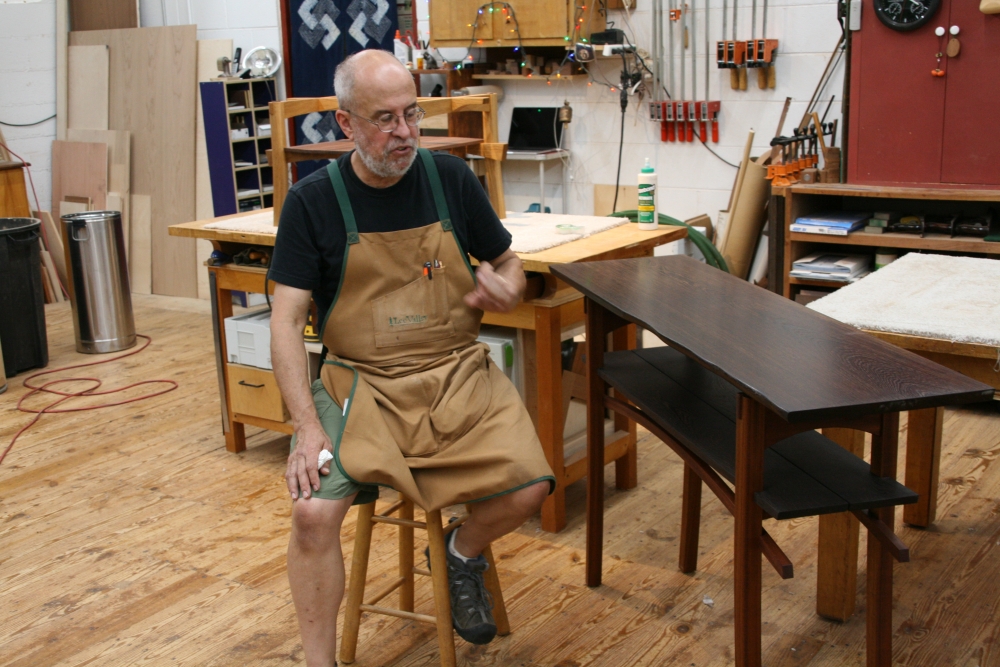
Bob Ortiz with a table like those he shows his students how to build
“Since 2008 when the financial crisis happened, most people who have small businesses — if they’re not still recovering — are trying to figure out how to move into the future. . I spent about eight years trying to figure out how to survive in the furniture business, because like many small industries it’s completely different than it was prior to 2008.
I think of 30 years of making furniture as two generations.
“The first generation of people I made furniture for, they’re retiring, downsizing, moving into assisted living, in some cases passing on. I asked those folks, what are they doing with their artwork and their furniture, with their silver, china, and most of them tell me they’re taking it to second-hand stores. Their children don’t want it, their grandchildren don’t want it. The generation that’s replacing that older cohort are in a very different place than my parents or my grandparents were. They’re starting families much later; they’re moving through different careers, different jobs every year, so that stability isn’t there. They’re living with a lot more debt.
“So over the years, I’ve been asking myself, what’s the strategy here? Who wants furniture; who needs furniture? And the more I listened to people and read articles, I realized that there are two things going on. One thing is, that the generation that is just about starting to retire or recently retired they no longer want to buy art or craft: they want to make it. The other interesting thing is that their children and grandchildren are not buying hand-crafted furniture. So about a year and a half ago I came up with this idea that I call the Chestertown vacation workshops.
“Basically, it’s this: come and spend a week with me. It’s one on one, it’s not a group thing. Immerse yourself in the making of a beautiful object that’s useful. I’ve been making this line of furniture now for 20 years, and so my comfort with it, my ability to pass along what I’ve learned in those 20 years, is part of what the workshop’s about.
“I try to be real clear; this is not about starting a woodworking school. If you’re coming to one of my workshops, it’s about come, spend a week, we’ll go from soup to nuts. Picking out the wood, making the pieces, designing them, putting them together, and at the end of the week you get to take it home.”

Part of the Robert Ortiz Studio
Who are the workshops aimed at? Ortiz said, “I’ve had people with a little bit of woodworking experience, people with no woodworking experience. I’ve had men and women who spent their career behind a desk, who finally want to get out from behind that desk and make something. I’ve had several women who weren’t allowed to take shop in high school who finally said, you know, I’m going to make myself something.”
The Spy asked, “What kinds of skills are they going to need for the workshop?”
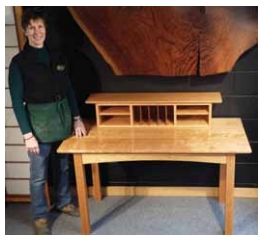
Workshop participant and project.
Ortiz said, “To a certain extent, when you come here, I don’t care if you’ve been a CEO, I don’t care if you’ve been a lowly worker – everybody is a private here, except for myself. The most important thing is for people to be willing and able to concentrate and to follow directions. The one skill that is really helpful is that you’re a problem solver. If you’re a good problem solver, it goes quickly. If not, we have to spend a little more time making sure that when it’s time to make a cut or put something together, that you’re able to do it right.
“Somebody who doesn’t have a lot of experience, or who has no experience, may wind up saying to themselves, well, gee, how am I going to take that workshop? Well, what I tell people is, you know all those people who are climbing up Mount Everest with a guide? Most of those people – they’re not mountain climbers. They’re people who pay a lot of money to have somebody shepherd them up the mountain, hopefully they make it, hopefully they come back down the mountain and have a wonderful experience to talk about. Well, in my case, I’m shepherding you through the process of making a piece of furniture. My job actually ends up being to make all the test pieces to give the student the confidence that they’ll be able to make the cut.”
Ortiz takes a good bit of pride in the quality of work his students are able to produce. He said, “Back in October I had an alumni weekend. I invited everyone who had taken a workshop to come and bring their piece of furniture and have it out on the floor. It was during the studio tour that happens in Kent County, because I wanted other people to see what participants had made, and the quality of what people were able to achieve. On my website, I have lots of photos of things that people have made, and you’d be pretty amazed. And I had a CEO last week who told me his doctor told him he needed to find something to do as a hobby. So he hadn’t taken wood shop since high school. I was pretty amazed. He didn’t answer his phone once during the course of the week. So I think the most important thing is to leave your daily routine behind you and be able to immerse yourself in the craft and in all the nuances and all the focus that it takes in order to make something with your hands and make it beautiful.

Alec Dick of Chestertown making a table in an Ortiz workshop
“The process – most of these pieces take about five days. And in those five days, my hope is that people are willing to come into my world, see how I spend my day. And my day involves focusing on the work that I’m doing, focusing on the details, and trying to get my students, the folks who are taking my workshops, to focus on those details just as much as myself, so that at the end of the week they take home this piece that’s as good as, or nearly as good as, something that I’ve made.
“I mentioned earlier that older people are giving their furniture, their silver, their china to second-hand and thrift stores. The kids don’t want the furniture that their grandparents or parents bought. What he said took me by surprise and it opened up a door that I just wasn’t thinking was there. He told me he brought home the first piece of furniture that he made from the workshop, and in the course of a couple of weeks, his three sons came to visit. And each of them said to him, “I want that when you die.” So it became clear to him, ‘Well, OK, I need to make three pieces of furniture, one for each.’
“But what’s interesting to me is, now we’re talking about a heirloom that’s going to stay in the family, hopefully for several generations.”
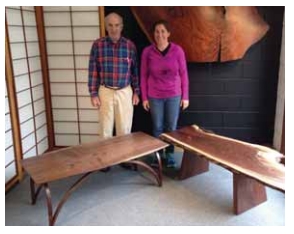
Workshop participants and project.
Ortiz knows what that means. Among all the fine pieces in his shop, he showed the table his computer sits on. “That’s a table that my father made when we lived in a little apartment in Greenwich Village when I was a kid. My father had no workshop – he was a factory worker, he was a metal worker. But that was a formica and metal table that he made. It’s always something that I’ve kept close by. And I guess to a certain extent the workshops are just a continuation of that. So – that’s what the workshops are about. The workshops are about legacy; the workshops are about coming and having fun; the workshops are about something, take it home, get to say every day, ‘I made that.’
The other thing that folks should know, I’m also willing to entertain other people’s designs. It sometimes costs a little more because I’ve got to figure out how we’re going to make them within the time frame.”
For more information about the workshops, and about Ortiz’s furniture, visit his website.
Furniture from the Daniel and Sophia furniture lines, made by Bob Ortiz in his Chestertown Studio:
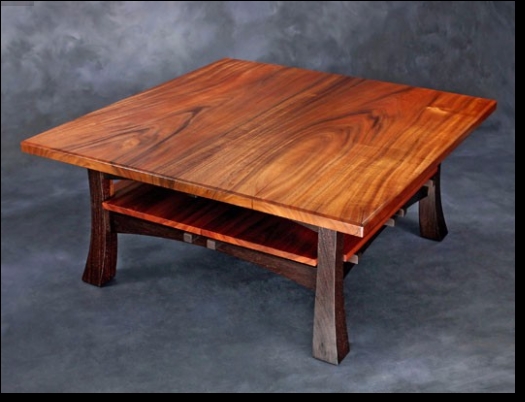
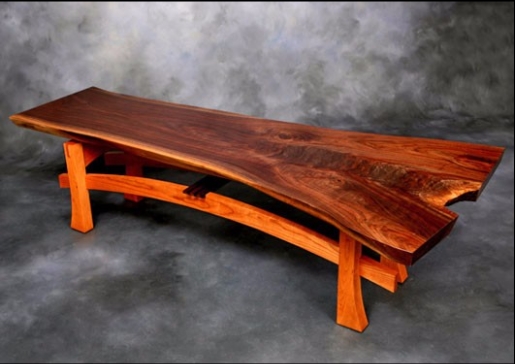
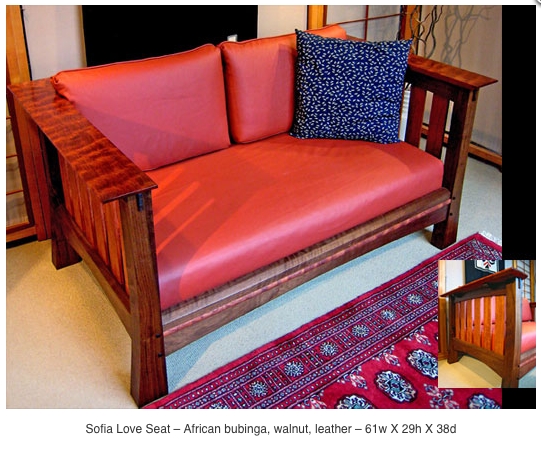
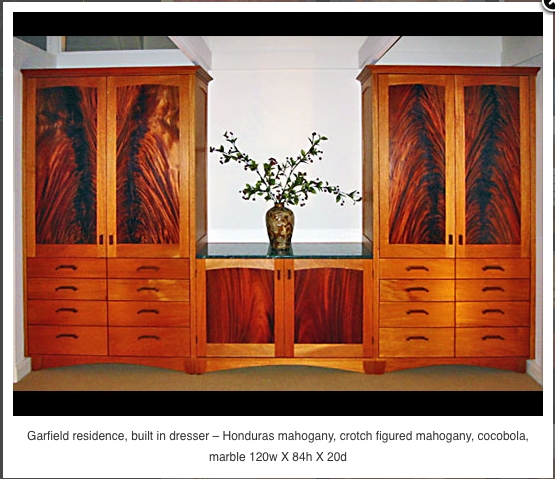
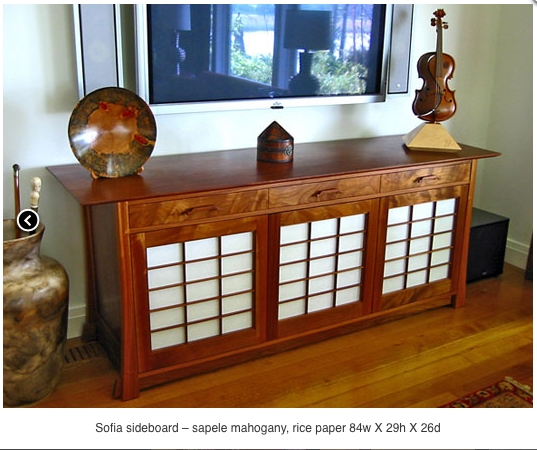
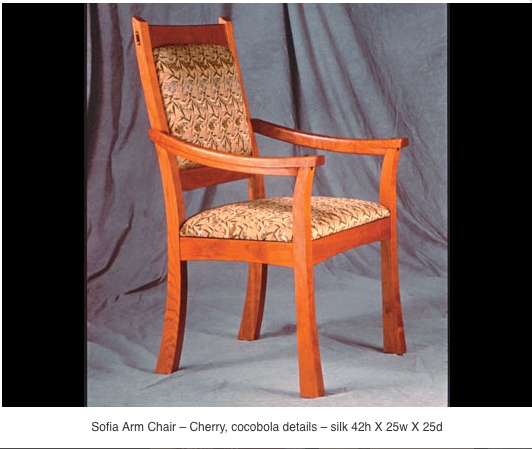
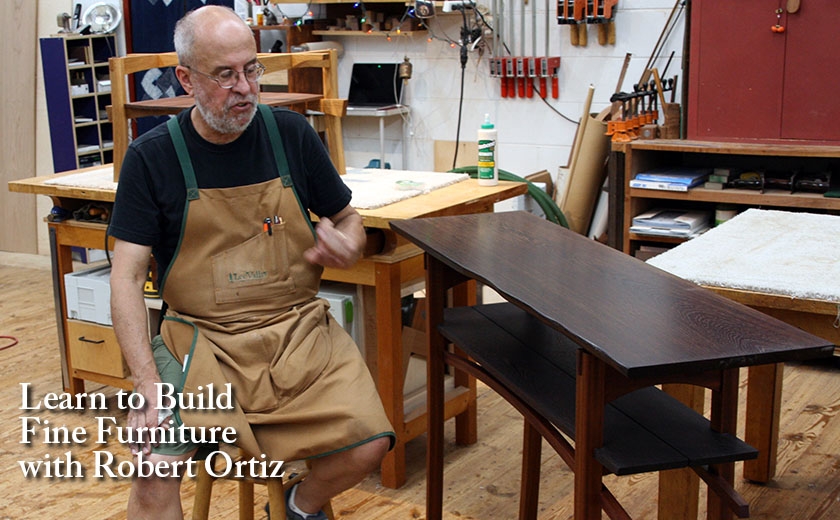


barbara L Ferris says
Bob, I have been mesmerized by your furniture since I came to town in early 2000. So beautiful! Have you thought about possibilities of making musical instruments?! Barb Ferris
Robert Ortiz says
Barb, thank you for your kind words. I’ve always believed that the challenge of making something useful AND beautiful is enough of a mountain to climb. I put the idea of making something useful, beautiful AND have it produce exquisite sound in the category of “pushing my luck.” If I had it to do all over again though I’d like to think that maybe I’d take that fork in the road.
Gordon Benson says
I have had the rewarding experience of three workshops with Bob Ortiz. As a result, I was able to accomplish more in each of those weeks than I would have on my own in weeks or months. This resulted in items in which I could take pride and impress my wife with fine furniture that is compatible with our lifestyle. In addition, I was able to use walnut that I harvested from our yard in Pennsylvania years ago in anticipation of retirement. I can highly recommend an Ortiz workshop for anyone interested in woodworking. You will benefit from the Ortiz expertise in a cordial environment.
Clotilde Blake says
What a wonderful article on Bob’s fantastic work. The idea of teaching others how to create and perfect a piece of wonderful wood and make a product to take with you to share with your family or simply to admire in your home, is just so admirable. I have been to the shop and always been fascinated by the beauty of the wood that Bob has chosen for his pieces. Who knew that this creativity would emerge and Bob would develop such a satisfying career that he can share with others. What a legacy! Clotilde Blake